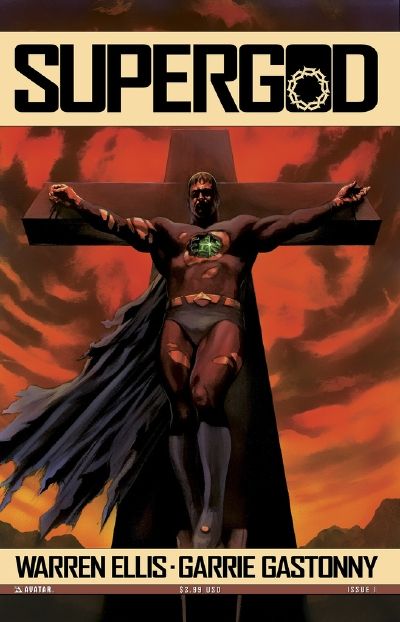This is the third part of a thematic trilogy of superhero work Warren Ellis has done for Avatar, which he's detailed as: "'Black Summer' was about superhumans who were too human. 'No Hero' was about superhumans who were inhuman. 'Supergod' is about superhumans who are no longer human at all, but something else."
"Supergod" is different from the previous two, partly because Juan Jose Ryp isn't drawing it, partly because of five-issue length, but mostly because of the way in which Ellis tells the story. Unlike the first two, which were narratives that unfolded in front of us, "Supergod" is a lecture, of sorts, a recounting of what has happened.
Simon Reddin, a British scientist, sits in the ruins of London, lights up a joint, and talks to a counterpart in America via phone about the creation of superhumans. Beginning with a British space shuttle in the 1950s that resulted in the three astronauts being changed by space fungi into a tri-headed being worshipped by its handlers and continuing on through India's creation of Krishna to solve their problems and mentions of Iran's attempt to build an angel, the story isn't simply one of creating superhumans, it's one of creating deities. Ellis takes the idea of humanity's need for something bigger to believe in, something to solve its problems and take care of things, and applies it to superhumans, and the results are somewhat jarring.
The cover has a Superman-esque hero on the cross, which is almost what you expect from a comic titled "Supergod" and in the hands of a lesser writer, that's what you'd get. This, though, is much more serious and thoughtful, narrowing in on the idea that a superhuman wouldn't think like a regular human, it wouldn't have the same concerns, it wouldn't focus on saving cats from tress or stopping bank robberies. It would slaughter millions to solve India's overpopulation crisis. It would be alien to us, it would be a god in the most sincere and terrifying senses of that concept.
Joining Ellis on art is Garrie Gastonny, a relative unknown, but his work here is impressive. It conforms to the general look of most Avatar titles, while also delivering some stronger than average visuals. He's asked to do a lot in this issue from drawing Reddin talking a lot, something that he makes visually interesting, to a space shuttle launching, and the various superhumans that are shown. The writing calls for an artist that can do realism well and that's what Gastonny does here, creating a world that looks and feels very much like ours where these superhumans seem alien and non-human. They don't fit into the visual tone on the book, particularly Krishna who looks like he's in the wrong comic, but that makes this better.
Less a proper narrative and more a history lecture, "Supergod" #1 is about ideas, not characters. How much you can get interested in those ideas will determine how much you'll enjoy this book. Ellis' writing is inventive and unique and, if this series continues with the ideas introduced here, "Supergod" may be a template, of sorts, for numerous superhuman stories in the near future.

